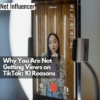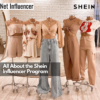Influencer
VFX Creator Queen Chelsea Reveals How She Reached Social Media Stardom
From her humble beginnings in film industry editorial work to becoming a social media sensation, visual effects artist Chelsea Laufer, known to millions as Queen Chelsea, is pushing the boundaries of VFX content.

Her unique blend of technical skill and storytelling prowess captivates large audiences on platforms like TikTok, Instagram, and YouTube.
In an exclusive interview with Net Influencer, she shares her success story, which is marked by brand partnerships and a strategic approach to income diversification.
As the visual effects industry experiences what Chelsea calls its “heyday” in advertising, her predictions of content creation and her plans to merge traditional filmmaking with VFX techniques show where the creator economy is headed.
How Chelsea’s Hobby Became a Career
Chelsea initially studied film and TV production. She started creating VFX content on TikTok as a hobby.
“I always liked visual effects but didn’t plan to pursue them professionally. It was more of a hobby,” Chelsea tells us.
“My first video that hit a million views was a tutorial of dancing shoes,” she recalls.
This success was followed by a video of her jumping into a coffee mug, which garnered over 34 million views on TikTok and caught the attention of industry professionals.
Chelsea attributes her success to technical skills and storytelling ability: “Many of my visual effects skills are self-taught because they were just from tutorials and trial and error. Whereas my schooling focused more on telling a story.”
“I think that’s how you make really interesting and memorable content: to have something you’re saying, telling, and showing rather than just ‘here’s an effect,'” she explains.
Her content has developed significantly since she started.
“I’ve learned a lot about what works on social media specifically versus making things just for the sake of it,” Chelsea notes.
She has progressed from creating simple visual effects with a stationary camera to producing complex 3D shots with moving cameras.
The Art of Visual Storytelling
Chelsea’s approach to creating viral VFX content combines spontaneity with meticulous planning.
“I don’t have a strict schedule per se,” she admits. “I try and come up with things weekly or on a somewhat weekly basis.”
Once an idea takes shape, Chelsea’s process becomes more structured.
“The next step is usually jotting down quick storyboards or just trying and visualize it in my head,” she explains. Collaboration plays a key role, with her boyfriend assisting in filming.
Chelsea’s dedication to perfection is evident in her filming process.
“Usually, all my videos are just one shot, so we’ll do the single shots probably 10 to 20 times,” she reveals.
This commitment extends to reshooting if necessary: “There have been cases where I’ve put it into the editing software and realized we could have done something better. Then, we reshoot it.”
The editing phase is where Chelsea’s problem-solving skills shine. “Every video is different. It’s like solving a puzzle every time you edit something,” she notes. This phase can be intensive, with Chelsea spending “20 to 40 hours” on a single project.
Despite her success, the visual artist acknowledges the challenges of content creation, particularly in maintaining motivation.
Her advice? “I have to post it for myself. If I get into a mental rabbit hole where I cannot post anything because it won’t be good enough or people won’t like it, I have to stop and stop myself and make something purely for me.”
Chelsea values the autonomy her career as a content creator provides. “I love the freedom that it gives me the most,” she says, highlighting her ability to choose projects and manage her schedule.
For her, the flexibility extends to her personal life, allowing her to pursue her passion for travel while continuing to create content.
Global Reach, Local Touch
Chelsea employs a nuanced approach to sharing her work across various social media platforms.
While the core content remains consistent, she slightly tailors her presentation strategy to each platform’s unique characteristics and algorithms.
“What I post is mostly the same across all the platforms. The variation would be in the captions,” Chelsea explains.
For Instagram, she crafts “quick, snappy caption[s] that’s easily shareable,” For YouTube Shorts, she considers how the content will appear on a user’s homepage alongside the thumbnail.
Chelsea’s audience engagement strategy emphasizes kindness and responsiveness. “I try to respond as often as I have the capacity to do so,” she says.
The content creator notes a particular affinity for Instagram, where she feels a stronger sense of community.
“I think [Instagram] is where I feel the biggest sense of community, and I feel like that is my main platform,” she shares.
While Chelsea monitors analytics, she finds them “more interesting than useful necessarily.”
Her content appeals to a broad demographic while maintaining a family-friendly approach.
“I know a lot of kids do watch it, so I’d say that sort of plays into me keeping it family-friendly,” she explains.
One of Chelsea’s key insights from her analytics is her international audience, which influences her content creation: “I try and make videos that you can watch even if you don’t speak English or if it’s not your first language.”
Despite these insights, Chelsea maintains a balanced perspective on data-driven content creation.
“I’m not particularly data-driven in that sense. I think it would stress me out to [try] more than anything,” she concludes.
Monetizing Creativity
Chelsea has developed a multifaceted approach to monetization.
Despite limitations for Canadian creators on some platforms, she has successfully diversified her income streams.
“In Canada, we don’t get as many monetization opportunities as they do in the U.S.,” Chelsea tells us.
Her revenue breakdown reflects this challenge: “YouTube does [pay], thankfully. So, part of my content strategy is my monetization plan through my YouTube income. I’d say that’s probably about 10% of my income. And then the other 90% is from brand deals, brand partnerships.”
To further diversify, Chelsea is developing a beginner course in visual effects. “That way, I can diversify my income stream and have a product that’s helpful to people because so many people have asked me about it,” she says.
Brand Partnerships
Chelsea’s niche in visual effects has proven advantageous for brand partnerships.
“I think visual effects is a fantastic niche to be in right now because it’s an easy way to blend marketing with watchable online content,” she notes.
Her collaborations with brands like Adobe have been particularly successful due to her natural alignment with her work.
When choosing partnerships, Chelsea considers several factors: “Timing for one. I can’t do it if I have too many things going on. I do look at whether or not the brand aligns with my values as well.” She also ensures that budgets align with her rates.
Chelsea aspires to combine her passion for travel with her work. “My biggest goal right now is getting to do more travel work. And so, I would love to collaborate with airlines, hotels, or something that allows me to do that.”
Chelsea on the Future of Visual Effects
Chelsea provides insights into the often misunderstood world of influencers and content creators.
She emphasizes the distinction between “standard influencers” and those with specialized skills like visual effects.
“One thing that I think even other influencers are surprised to hear is how long videos take when you’re doing it with a skill set like editing or people making something from scratch,” Chelsea explains.
While acknowledging that being an influencer might seem easy, Chelsea notes, “There is still a lot of work that goes into it.”
She advises new creators to focus on intrinsic motivation rather than external validation. “Doing it for yourself is the best way to go about things,” she says, cautioning against the pitfalls of seeking internet fame as a primary goal.
Merging Filmmaking and VFX
Chelsea notes that “VFX is having its heyday right now with advertising,” adding the trend of CGI products in marketing campaigns.
She predicts a potential resurgence of horizontal content creation driven by ads introduced by streaming services.
“I think there’s going to be sort of an evolution in advertising on that side where maybe horizontal content creators are going to make a comeback,” Chelsea speculates.
Looking ahead, Chelsea aims to merge her filmmaking background with her current expertise in visual effects.
“I’d love to return to my filmmaking roots and sort of merge what I went to school for with what I do now,” she says.
Her plans include creating longer-form content for YouTube and potentially establishing a production studio in the future.
Chelsea concludes with an optimistic outlook on her career: “I’m so lucky to have this job because it allows me to have fun every day. And for that, I will be eternally grateful.”





















